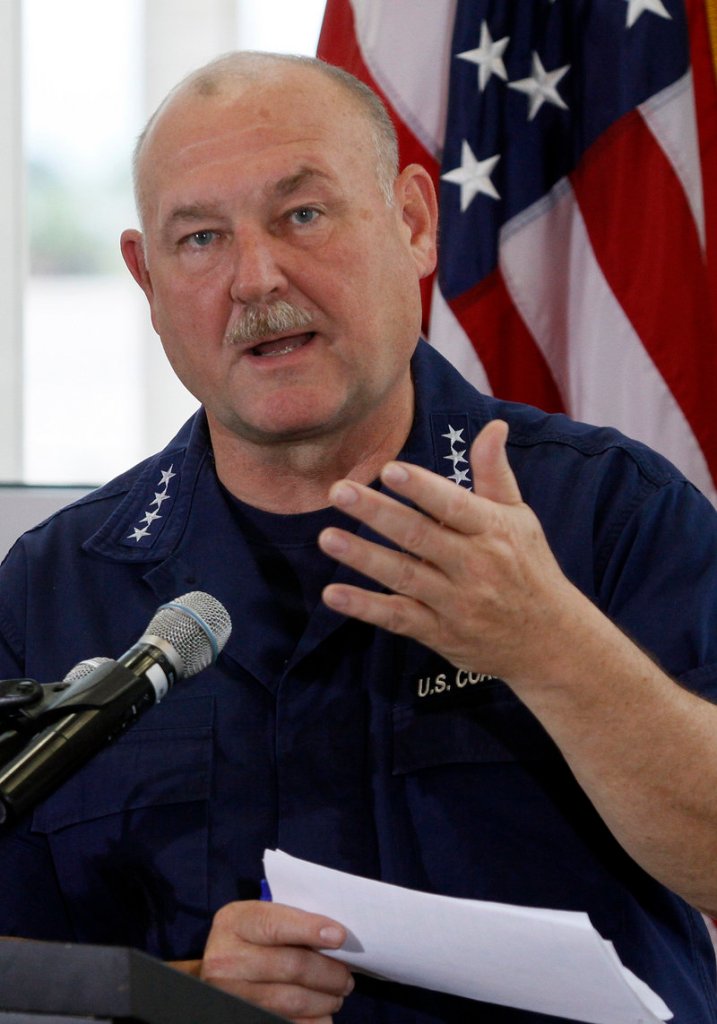NEW ORLEANS – Tropical Storm Alex steamed across the Gulf of Mexico on Monday on a path that could keep it away from BP’s busted well but could still stir up heavy winds, rain and choppy seas that drive the oil deeper inland and bring much of the cleanup to a standstill.
midweek, boats skimming the sludge from the water may have to return to port for their own safety, and the floating oil-containment booms could be rendered useless by waves slopping over them and may have to be pulled out of the water.
The upside is that the storm could stay far enough away that BP will not have to abandon its efforts to capture much of the crude spewing from the sea floor.
Nor is the storm expected to interrupt BP’s drilling of a relief well, considered the best hope of plugging the leak.
“We are watching very, very closely,” said Coast Guard Adm. Thad Allen, the government’s point man on the crisis. “As it stands right now, absent the intervention of a hurricane, we’re still looking at mid-August” for completing the relief well. Earlier Monday, a BP executive said the well would be done by early August.
Still, Alex — expected to reach hurricane force by the time it hits land near the Mexico-Texas border, possibly Thursday — is giving new urgency to BP’s efforts to make its operations at the well as hurricane-resistant as possible.
The company said it hopes to install a new oil-capturing system by next week that would allow BP to disconnect the equipment faster if a hurricane threatens and hook it back up quickly after the storm passes. Right now, BP would need five days to pull out if there is a hurricane. The new system being developed, which uses a flexible hose, would cut that to two days.
And if there were a hurricane, it could shut down the drilling operation for up to two weeks, Allen said.
The containment system now in place is capturing nearly 1 million gallons per day from the well, which is spewing as much as 2.5 million gallons a day, according to the government’s worst-case estimate. If the equipment had to be removed because of a storm, oil would gush full force into the ocean again.
In other developments, BP strongly denied reports in the Russian media that the company’s CEO, Tony Hayward, is stepping down. Hayward has made a string of gaffes that have angered politicians and Gulf Coast residents.
Meanwhile, Alex was swirling through the Gulf with winds of 60 mph. It was expected to become a hurricane today, and could have winds as high as 120 mph by Wednesday.
While the storm center wasn’t expected to approach the site of the spill, Stacy Stewart, senior hurricane specialist at the National Hurricane Center, said Alex’s outer winds could push oil farther inland.
Crews are also expecting up to 12-foot waves at the site of the gusher 50 miles off Louisiana, Allen said.
He said that is not enough to stop the tanker that is sucking up large quantities of oil through the cap on the well, or a second vessel that is burning off hundreds of thousands of gallons at the surface.
What forecasters are most concerned about, said Ed Rappaport, deputy director of the National Hurricane Center in Miami, is the slim chance that the distant storm could generate winds of 39 mph or so in the spill area, which would probably mean curtailing the cleanup.
Crews may have to pick up booms in the storm’s path before they get tossed around.
“What boom they don’t pick up — and there’s miles and miles of it, so there’s no way they can pick it all up — will end up back in the marsh,” said Ivor van Heerden, former deputy director of Louisiana State University’s Hurricane Center.
At Grand Isle, La., crews already were packing up boom and moving other supplies and equipment, Coast Guard Cmdr. Joe Higgins said. He said Alex could send 2 feet to 4 feet of storm surge there.
“We have had to move a lot of material from low-lying areas,” he said.
“Our concern now is the safety of the people working on this.”
Rough seas would make skimmer vessels less effective and could put crews at risk.
Pulling boats and crews off the water could cost precious time, said Nancy Kinner, co-director of the Coastal Response Research Center at the University of New Hampshire.
Equipment has to be stripped down, packed and protected from the force of the storm, and then has to be reassembled and deployed again — a task that takes resources and hours away from cleanup and containment, she said.
“It not only prevents you from being on the water, it delays you in how long it takes to get back on the water,” Kinner said.
Send questions/comments to the editors.




Success. Please wait for the page to reload. If the page does not reload within 5 seconds, please refresh the page.
Enter your email and password to access comments.
Hi, to comment on stories you must . This profile is in addition to your subscription and website login.
Already have a commenting profile? .
Invalid username/password.
Please check your email to confirm and complete your registration.
Only subscribers are eligible to post comments. Please subscribe or login first for digital access. Here’s why.
Use the form below to reset your password. When you've submitted your account email, we will send an email with a reset code.